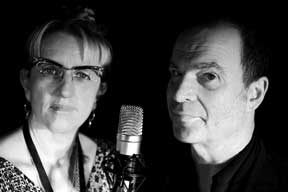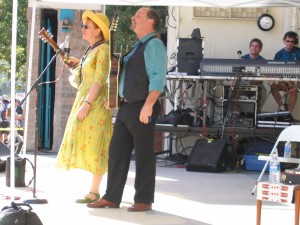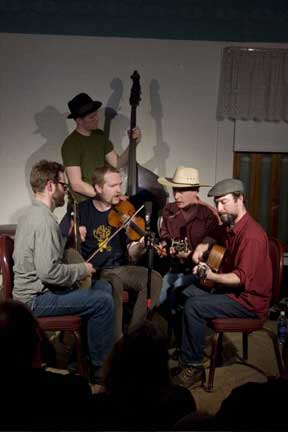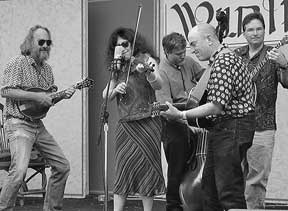
Del Rey Steve James and their Rode NT-1. This mic has been from Paris to Australia. Festivals to barn dances, it delivers consistent, realistic sound.

See the happy expressions on the faces of the sound guys? That’s because they just had an hour of blessed rest…
Steve James and I get a lot of questions from other musicians about our one mic set-up: no D.I.s? No monitors?
Just ONE MIC?!?
Yes indeed, and we want to encourage more acoustic musicians to really play acoustic.
Plenty of other bands besides us do it already-Foghorn Stringband, Del McCoury, Suzy and Eric Thompson, just to name a few. Not to mention the great shows of the past, from Benny Goodman at Carnegie Hall to, well, just about everybody before WWII!
We love our mic, the excellent Australian-made Rode NT1
It’s inexpensive, hardy (I dropped it off a barstool onto a concrete floor and it was unscathed) and it has served us well at big shows (the mainstage at Merlefest) and little shows. I’ve used it with a four piece jazz band and as a solo. Suzy Thompson and I had a little trouble singing together, due to height differences, but she solved that with a nice pair of platform shoes…
The cool thing about one mic is that YOU mix your sound, not some random guy who may not know your songs or anything about the kind of music you play. Guitar too loud? Step back. Vocal too soft? Lean in. You do have to be able to play your instrument dynamically and look up and pay attention to your bandmates; which, sadly, may not be possible for some acts on the scene…
Another cool thing is that your days of trying to hear yourself in the monitors, tortured by bad stage mixes that have nothing to do with what your audience is experiencing are OVER! Your soundcheck will take 15 minutes, no matter how many in your band and by listening to the actual sound on stage and the sound from the mains, you and your audience will be hearing near the same thing.
Anyway, we love it and we encourage you to try it-once you get back to listening to the sound coming from your instruments, the electronics just sound tacky.
Here’s what Caleb Klauder the mandolin player with Foghorn Stringband has to say about it:
“We like to use this set up because it is the closest thing we have found to just playing around the living room. The single microphone gives us the least hassle,
and the most natural sound while playing on a stage. We always use the AT 4033. Its a workhorse.
I have found that in order to be effective, you can’t be shy about your volume, this doesn’t mean that you can’t be dynamic. We sit down when we play so we do not have the flexibility of moving for solos and singing, so we really have to stay in a tight group and put out a good deal of sound especially for vocals. We play in a real ensemble style, where there are no solos, so every body has to listen real well and adjust their own volume to fit the collective sound. This technique doesn’t work if you sort of “half do it”, the sound guy will always try to turn you up and then you’ll get feedback.
I like the limitations that one microphone gives you, it really makes you think about your sound and what you want to come across to the audience. Using one mic also takes the sound man out of the mix, literally, and lets you decide what instrument is showcasing at any given point. I call this the DYI technique because by using one mic you are really taking it into your own hands to present your music. I would also like to say that I don’t think using one mic is the sort of “ho hum, we’ll just play” situation: you really have to think about it and be intent on what you are doing, otherwise it just comes out kind of weak.”
Fiddler and singer Suzy Thompson says: “We’ve been using one mic for at least 5 years now, with the Bluegrass Intentions (our bluegrass band) although now we use two wide diaphragm mics instead of one, as a duo, and sometimes even with the Aux Cajunals (our Cajun dance band). We like it for several reasons:
1. If you are hauling your own sound equipment, set up and tear down takes only a fraction of the time — not only are there fewer mics, stands and cords, but you don’t need to bring monitors either.
2. If you have an idiot for a sound person, it doesn’t matter — you mix yourself
3. No pesky monitors to feed back and obscure the view of your feet
4. The band gets a nice social thing going gathered around the mic — there’s more movement in and out of the mic, which gives the audience something to watch. Instead of relating to the microphone, the musicians relate more to each other.
We have two large diaphragm mics. The Audix is more flattering for vocals, the Audio-Technica has a more crystalline quality, better for plucked instruments. I keep changing my mind on which is better for fiddle, I think maybe it depends on context. For the Intentions and for Thompson String Ticklers, we use both mics and that seems to work out better than just one, because there are so many people (5 in the Intentions, 6 in the Ticklers) If we’re just using one, we use the Audix.”
Finally, here’s an unsolicited testimonial:
“Hello Del. Thanks for this information. I’ve become a big fan of the one mic approach. My band (Vonda McConda, mostly amateur, 7 of us) had played out a couple of times with a standard SM-58/close mic/monitors setup. I hated it. Couldn’t see the others, could only hear them through the monitors. Then I got an Ear Trumpet Labs Mic. We’ve used it a few times now with only 3 or 4 of us playing, and it’s great! It allows us to play much more like we do when we’re just playing at home for fun; everyone in a circle (or close to it). I’ve just purchased a second mic (AT4033) to accommodate the larger group. I figure I’ll keep the ETL as the vocal/harmony mic, and set up the AT4033 as an instrument mic. Between the two, all of us are covered. For me, the single mic approach makes the difference between not being interested in playing out, and having a blast playing out. Anyway, thanks for spreading the word. George” George also has started using a Go-Rack to goose more volume from his set-up. That’s more complicated than I like to get, but read his thoughts here.
If you want to try it out on the cheap, check out the MCA-SP1
Usually under $60 and I often use it when I travel light.
Still got questions? Email me and I’ll do my best to get you into our “cult”!

